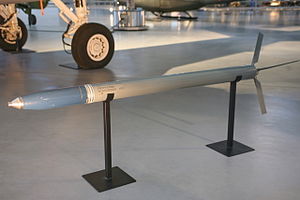Zuni (rocket)
| Zuni | |
|---|---|
 |
|
| Type | Air-to-surface rocket |
| Place of origin | United States |
| Service history | |
| Used by | United States military |
| Production history | |
| Produced | 1957–present |
| Specifications | |
| Weight | 79.5 pounds (36.1 kg) (motor only) |
| Length | 77 inches (2,000 mm) |
| Diameter | 5 inches (130 mm) |
| Warhead | various |
|
|
|
| Engine | Solid-fuel rocket |
|
Operational
range |
5 miles (8.0 km) |
| Speed | 1,615 miles per hour (2,599 km/h) |
|
Guidance
system |
None |
The Zuni 5-inch Folding-Fin Aircraft Rocket (FFAR), or simply Zuni, is a 5.0 in (127.0 mm) unguided rocket deployed by the United States armed forces. The rocket was developed for both air-to-air and air-to-ground operations. It can be used to carry various types of warheads, including chaff for countermeasures. It is usually fired from the LAU-10 rocket pod holding four rockets.
In the early 1950s, U.S. Navy engineers Naval Ordnance Test Station China Lake began to develop a new 12.7 cm unguided rocket to replace the High Velocity Aircraft Rocket.
The Zuni was designed as a modular system, to allow the use of different types of warheads and fuzes. One type of warhead was a proximity fuze, as the rocket was originally intended to be used as an air-to-air rocket. This led to its selection as the basis for the AIM-9 Sidewinder airframe in the early 1950s.
The Zuni was approved for production in 1957. A number of different launchers were tested for the Zuni, e.g. single launchers fitted to the Sidewinder launching rails of the Vought F-8 Crusader. However, four-tube LAU-10/A series pods became the most commonly used launcher.
The Zuni was widely used in the ground-attack role during the Vietnam War. However, on 1 May 1967 during a sortie against Kép Air Base, North Vietnam, LCDR Theodore R. Swartz of Squadron VA-76, flying from USS Bon Homme Richard, shot down a MiG-17 with Zuni rockets. This was the only MiG aircraft to be downed by a Douglas A-4 Skyhawk during the Vietnam War. Lieutenant Commander Swartz received the Silver Star for his action.
...
Wikipedia
